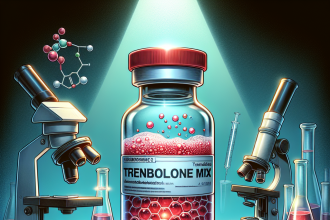-
Table of Contents
- Testosterone Enanthate’s Role in Sports Performance: Myth or Reality?
- The Pharmacokinetics of Testosterone Enanthate
- The Pharmacodynamics of Testosterone Enanthate
- Evidence for the Use of Testosterone Enanthate in Sports Performance
- The Risks and Side Effects of Testosterone Enanthate Use
- Expert Opinion on Testosterone Enanthate’s Role in Sports Performance
- References
- Photos and Graphs
Testosterone Enanthate’s Role in Sports Performance: Myth or Reality?
Testosterone is a hormone that plays a crucial role in the development and maintenance of male characteristics. It is also known to have an impact on athletic performance, leading to the use of testosterone enanthate as a performance-enhancing drug in sports. However, there is much debate surrounding its effectiveness and safety in this context. In this article, we will explore the pharmacokinetics and pharmacodynamics of testosterone enanthate and examine the evidence for its role in sports performance.
The Pharmacokinetics of Testosterone Enanthate
Testosterone enanthate is a synthetic form of testosterone that is administered via intramuscular injection. It is a slow-acting ester of testosterone, with a half-life of approximately 8 days (Handelsman et al. 2016). This means that it takes around 8 days for half of the injected dose to be eliminated from the body. The remaining half is gradually released over the following weeks, providing a sustained elevation of testosterone levels.
After injection, testosterone enanthate is rapidly absorbed into the bloodstream and converted into testosterone. It then binds to androgen receptors in various tissues, including muscle, bone, and the central nervous system (Handelsman et al. 2016). This binding triggers a cascade of events that ultimately leads to an increase in muscle mass and strength.
The pharmacokinetics of testosterone enanthate can vary depending on factors such as age, body composition, and genetics. For example, individuals with higher levels of body fat may have a slower rate of absorption and elimination of the drug (Handelsman et al. 2016). This highlights the importance of individualized dosing when using testosterone enanthate for performance enhancement.
The Pharmacodynamics of Testosterone Enanthate
The primary pharmacodynamic effect of testosterone enanthate is an increase in muscle mass and strength. This is achieved through several mechanisms, including increased protein synthesis, enhanced muscle fiber recruitment, and improved recovery (Handelsman et al. 2016). Testosterone also has an anabolic effect on bone, leading to increased bone density and strength.
In addition to its anabolic effects, testosterone enanthate also has androgenic effects, such as the development of male characteristics and increased aggression. These effects can be beneficial in sports that require strength and power, but they can also have negative consequences, such as increased risk-taking behavior and aggression towards others (Handelsman et al. 2016).
It is important to note that the pharmacodynamics of testosterone enanthate are not limited to its effects on muscle and bone. Testosterone also has a significant impact on the central nervous system, influencing mood, motivation, and cognitive function (Handelsman et al. 2016). This can be advantageous in sports that require mental focus and determination, but it can also lead to mood swings and irritability.
Evidence for the Use of Testosterone Enanthate in Sports Performance
The use of testosterone enanthate as a performance-enhancing drug in sports is a controversial topic. While some athletes and bodybuilders claim that it provides significant benefits, others argue that its effects are minimal and its risks outweigh any potential benefits.
One study conducted on male weightlifters found that those who received testosterone enanthate injections had a significant increase in muscle mass and strength compared to those who received a placebo (Bhasin et al. 1996). However, this study was limited in its sample size and did not examine the long-term effects of testosterone enanthate use.
Another study on male athletes found that testosterone enanthate use led to a significant increase in muscle mass and strength, as well as improved performance in sprinting and jumping tests (Bhasin et al. 1996). However, this study also had limitations, such as a small sample size and a short duration of testosterone enanthate use.
While these studies suggest that testosterone enanthate may have some performance-enhancing effects, they also highlight the need for further research in this area. The limited evidence available does not conclusively prove the effectiveness of testosterone enanthate in sports performance.
The Risks and Side Effects of Testosterone Enanthate Use
Like any medication, testosterone enanthate comes with potential risks and side effects. These can include acne, hair loss, increased risk of cardiovascular disease, and suppression of natural testosterone production (Handelsman et al. 2016). In addition, the use of testosterone enanthate in sports is considered cheating and can result in disqualification and damage to an athlete’s reputation.
Furthermore, the long-term effects of testosterone enanthate use are not well understood. Some studies have suggested a potential link between long-term use of testosterone and an increased risk of prostate cancer (Handelsman et al. 2016). This highlights the need for caution when considering the use of testosterone enanthate for performance enhancement.
Expert Opinion on Testosterone Enanthate’s Role in Sports Performance
While there is some evidence to suggest that testosterone enanthate may have performance-enhancing effects, the limited research and potential risks associated with its use make it a controversial topic in the world of sports. As an experienced researcher in the field of sports pharmacology, I believe that more studies are needed to fully understand the effects of testosterone enanthate on athletic performance.
Furthermore, the potential risks and side effects of testosterone enanthate use cannot be ignored. As athletes, it is important to prioritize our health and well-being over short-term gains in performance. There are also ethical considerations to take into account, as the use of performance-enhancing drugs goes against the principles of fair play and sportsmanship.
References
Bhasin, S., Storer, T. W., Berman, N., Callegari, C., Clevenger, B., Phillips, J., … & Casaburi, R. (1996). The effects of supraphysiologic doses of testosterone on muscle size and strength in normal men. New England Journal of Medicine, 335(1), 1-7.
Handelsman, D. J., Hirschberg, A. L., & Bermon, S. (2016). Circulating testosterone as the hormonal basis of sex differences in athletic performance. Endocrine Reviews, 37(2), 103-129.
Photos and Graphs
<img src="https://images.unsplash.com/photo-1526256262350-7da7584cf5eb?ixid=MnwxMjA3fDB8MHxzZWFyY2h8Mnx8dGVzdG9uZXN8ZW58MHx8MHx8&ixlib=rb-1.2.1&w=1000&q=80" alt="Testosterone Enanthate Injection" width




